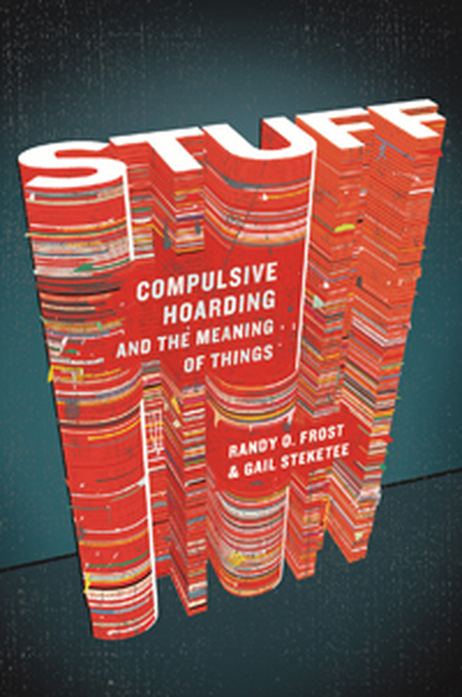
For the past decade, psychologists Randy Frost and Gail Steketee have studied hoarders: people who compulsively acquire a lot of stuff, and then have difficulty discarding the objects they obtain.
In their book Stuff: Compulsive Hoarding and the Meaning of Things, the two researchers detail how compulsive behaviors drive sufferers to pile objects throughout their homes. Illustrating the phenomenon through several case studies, Frost and Steketee identify the key traits that identify a hoarder, detailing the underlying causes and explaining how to minimize the effects of the emotionally exhausting disorder.
In an interview on Fresh Air, the researchers tell contributor Dave Davies that hoarders often don't realize the extent of their problems — even when confronted with photographs of the chaos in their cluttered houses.
"There's a phenomenon we refer to as 'clutter blindness,' " Steketee explains. "And when we take pictures and show [hoarders] the pictures later, they often have the impression of shock. It's like somebody else's home that they're looking at in the photograph, because to them that's not what it looks like when they walk in the house."
Frost and Steketee are also the co-authors of Buried in Treasure: Help for Compulsive Acquiring, Saving and Hoarding and the workbook Compulsive Hoarding and Acquiring: Treatments That Work.
Interview Highlights
On whether hoarders consciously notice their circumstances
Randy Frost: "Interestingly, when I showed up at [one particular client's] house, what she said to me was, 'When you're here, I'm aware of clutter, and it makes me feel awful. I get depressed; I look at myself as a horrible person. When you leave, I don't notice it anymore.' That is what a number of people have told us."
Gail Steketee: "And as you can imagine, they rarely invite anyone there. They're very ashamed."
On when collecting becomes pathology
Steketee: "[It's] when it crosses the line from ... collecting things to the point where there's distress — either to the person who has the problem or [for] those around them. And [when there is an] impairment — when they can't do the things that they [would otherwise] do in their ordinary lives, when they can't socialize or have people into the house or work effectively, when they can't spend time with their children and on and on."
Frost: "One of the questions we get all the time from people is, 'What's the difference between someone who has a hoarding problem and someone who is a collector?' What we've noticed is a couple of major differences between the two. First of all, when people collect things, they typically organize them in a pretty systematic fashion — and that doesn't happen in hoarding. The other thing is, when people collect things, they typically want to display them to other people. ... Hoarders want to keep things hidden because of the shame they have."
On traits common among hoarders
Frost: "These beliefs seem to be associated with some peculiar information-processing problems. That is, there are some problems with attention and sometimes a hyperfocus, problems with categorization — the ability to organize things. People who hoard tend to live their lives visually and spatially instead of categorically like the rest of us do."
On treatment options
Steketee: "One of the first things we start off with doing is trying to figure out how motivated they are to get over the problem. Because when they're with us, they feel embarrassed — but in their own home, they're not at all sure they want to get rid of anything. Part of that is trying to figure out [what] values they have for the future and what goals they have based on those values, and that can help us sort of set the stage — when they want to back out or they're afraid to get rid of something, we can double back to those goals."
Excerpt: 'Stuff: Compulsive Hoarding and the Meaning of Things'

Piles Upon Piles
The Story of Hoarding
I attach meaning to things that don't need it.
—Irene
I spotted Irene's home immediately. Despite its commanding view of the countryside from atop a hill, it was dark and gloomy. Overgrown trees and bushes hid much of the house from the street. The paint was peeling, and the fence needed mending. A car parked in the driveway was packed with papers and clothes. I had brought along my student assistant, Tamara Hartl, and as we walked toward the house, we could see boxes, newspapers, clothes, and an assortment of unidentifiable objects pressed against the windows.
We knocked on the front door but got no answer. We found a side door and knocked. Something stirred inside the house. Behind us, a door to the garage opened, and out stepped Irene, slightly overweight and rumpled, with straight brown hair and a friendly smile. She introduced herself with a nervous laugh and invited us in: "You can't get in that way. You'll have to come through the garage." A sea of boxes, bags, ski poles, tools, everything imaginable — all in a jumble, chest-high — covered the entire length and width of the garage. Along the wall was a narrow pathway to the only door to her house that was not blocked by debris.
Read more at http://www.npr.org/templates/story/story.php?storyId=126386317
Read more at http://www.npr.org/templates/story/story.php?storyId=126386317
No comments:
Post a Comment